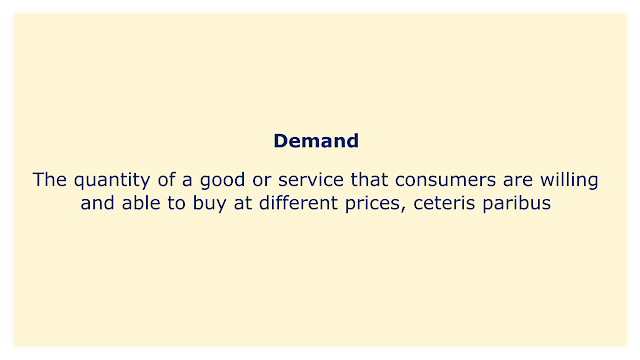 |
| Image: Moneybestpal.com |
Demand is a complex idea with many distinct definitions and methods of analysis. The quantity of a good or service that consumers are willing and able to buy at different prices, ceteris paribus, is generally referred to as demand (all other things being equal). The amount of a good or service that producers are willing and able to sell at different prices is represented by supply, which is another important factor in determining the equilibrium of the market.
Consumer preferences, income, the cost of alternatives and complements, expectations, population size, and other factors can all have an impact on demand. The demand curve, which depicts the connection between price and quantity desired graphically, might change as a result of several events. Demand changes when people desire more or less of the good or service than they did previously at every price point. For instance, as consumer income rises, they might purchase more expensive items overall, shifting the demand curve for those items to the right.
Depending on the nature of the good or service and how responsive it is to changes in price or income, demand can also be divided into many sorts. For instance, some goods or services have elastic demand, which means that even a small change in price can have a substantial impact on the quantity demanded. Luxury goods, non-essential commodities, products with numerous substitutes, etc. are examples of products with elastic demand. On the other hand, some goods or services have inelastic demand, which means that even when their prices change dramatically, the amount of them that people want doesn't change much. Products with inelastic demand include those that are essential, addictive, have few replacements, etc.
Derivative demand is another sort of demand, which is defined as the desire for a good or service that results from the demand for a different good or service. For instance, the demand for steel is generated from the demand for vehicles or structures made of steel. Similarly to this, the demand for commodities and services that require work as input leads to a demand for labor.
Demand is also applicable in the financial sector, where it refers to the amount of capital that consumers are prepared to lend or borrow at different interest rates. The term "financial capital" describes funds or possessions that can be invested in profitable ventures or used to create revenue streams. Demand for financial resources is influenced by a variety of variables, including anticipated investment returns, risk preferences, time preferences, inflation predictions, etc.
In competitive marketplaces with numerous buyers and sellers who have complete knowledge of each other's actions and no entry barriers, externalities, market power, etc., the interaction between supply and demand determines how prices are established. When supply and demand balance at a specific price level in such marketplaces, there is neither an excess of supply (surplus) nor an excess of demand (shortage). Yet not every market is completely competitive. In some markets with limited numbers of customers or sellers who can influence pricing due to information asymmetry, entry restrictions, externalities, etc., imperfect competition may exist. In certain markets, equilibrium might not take place or might lead to ineffective results.
Understanding demand is crucial for comprehending how markets operate, customers behave, producers react, regulations influence results, resources are distributed, welfare is measured, etc. Demand affects a variety of disciplines, including economics, business, and finance. environmental science, political science, psychology, sociology, etc. Demand also involves moral, social, cultural, and environmental aspects that demand critical analysis.
Hence, demand is a complicated phenomenon that calls for careful interpretation, application, comparison, contrast, synthesis, evaluation, etc. It reflects preferences, limitations, opportunities, incentives, trade-offs, rationality, irrationality, uncertainty, expectations, etc. rather than being only a basic expression of wishes.
